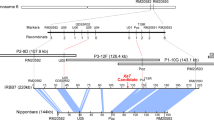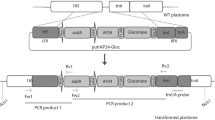Abstract
Antibiotic-resistance genes of bacterial origin are invaluable markers for plant genetic engineering. However, these genes are feared to pose possible risk to human health by horizontal gene transfer from transgenic plants to bacteria, potentially resulting in antibiotic-resistant pathogenic bacteria; this is a considerable regulatory concern in some countries. The Atwbc19 gene, encoding an Arabidopsis thaliana ATP-binding cassette transporter, has been reported to confer resistance to kanamycin specifically as an alternative to bacterial antibiotic-resistance genes. In this report, we transformed hybrid aspen (Populus canescens × P. grandidentata) with the Atwbc19 gene. Unlike Atwbc19-transgenic tobacco that was only resistant to kanamycin, the transgenic Populus plants also showed resistance to three other aminoglycoside antibiotics (neomycin, geneticin, and paromomycin) at comparable levels to plants containing a CaMV35S-nptII cassette. Although it is unknown why the transgenic Populus with the Atwbc19 gene is resistant to all aminoglycoside antibiotics tested, the broad utility of the Atwbc19 gene as a reporter gene is confirmed here in a second dicot species. Because the Atwbc19 gene is plant-ubiquitous, it might serve as an alternative selectable marker to current bacterial antibiotic-resistance marker genes and alleviate the potential risk for horizontal transfer of bacterial-resistance genes in transgenic plants.





Similar content being viewed by others
References
Bar-Nun S, Shneyour Y, Beckmann JS (1983) G-418, an elongation inhibitor of 80 S ribosomes. Biochim Biophys Acta 741(1):123–127
Bevan MW, Flavell RB, Chilton MD (1983) A chimaeric antibiotic-resistance gene as a selectable marker for plant-cell transformation. Nature 304(5922):184–187
Dai WH, Cheng ZM, Sargent WA (2003) Regeneration and agrobacterium-mediated transformation of two elite aspen hybrid clones from in vitro leaf tissues. In Vitro Cell Dev Biol Plant 39:6–11
Dai WH, Cheng ZM, Sargent WA (2004) Expression of the rol B gene enhances adventitious root formation in hardwood cuttings of aspen. In Vitro Cell Dev Biol Plant 40(4):366–370
Darbani B, Eimanifar A, Stewart CN Jr, Camargo W (2007) Methods to produce marker-free transgenic plants. Biotechnol J 2:83–90
Dreesen TD, Johnson DH, Henikoff S (1988) The brown protein of Drosophila melanogaster is similar to the white protein and to components of active transport complexes. Mol Cell Biol 12:5206–5215
Farnum P, Al Lucier, Meilan R (2007) Ecological and population genetics research imperatives for transgenic trees. Tree Genet Genomes 3(2):119–133
Heinemann JA, Traavik T (2004) Problems in monitoring horizontal gene transfer in field trials of transgenic plants. Nat Biotechnol 22(9):1105–1109
Horsch RB, Fry JE, Hoffmann NL, Eichholtz D, Rogers SG, Fraley RT (1985) A simple and general-method for transferring genes into plants. Science 227(4691):1229–1231
Jefferson RA, Kavanagh TA, Bevan MW (1987) Gus fusions—beta-glucuronidase as a sensitive and versatile gene fusion marker in higher-plants. EMBO J 6(13):3901–3907
Kapaun JA, Cheng ZM (1999) Aminoglycoside antibiotics inhibit shoot regeneration from Siberian elm leaf explants. HortScience 34:727–729
Kumie K, Satomi T, Tomomi S, Sakiyo A, Etsuko I, Takashi T, Yoshikazu S (2002) Dominant-negative inhibition of breast cancer resistance protein as drug efflux pump through the inhibition of S-S dependent homodimerization. Int J Cancer 97(5):626–630
Levy-Booth DJ, Campbell RG, Gulden RH, Hart MM, Powell JR, Klironomos JN, Pauls KP, Swanton CJ, Trevors JT, Dunfield KE (2007) Cycling of extracellular DNA in the soil environment. Soil Biol Biochem 39(12):2977–2991
Lloyd G, McCown B (1981) Commercially feasible micropropagation of mountain laurel, Kalmia latifolia, by use of shoot-tip cultures. Comb Proc Int Plant Prop Soc 30:421–426
Luo K, Duan H, Zhao D, Zheng X, Deng W, Chen Y, Stewart CN Jr, McAvoy R, Jiang X, Wu Y, He A, Li Y (2007) ‘GM-gene-deletor’: fused loxP-FRT recognition sequences dramatically improve the efficiency of FLP or CRE recombinase on transgene excision from pollen and seed of tobacco plants. Plant Biotechnol J 5:263–274
Mentewab A, Stewart CN Jr (2005) Overexpression of an Arabidopsis thaliana ABC transporter confers kanamycin resistance to transgenic plants. Nat Biotech 23(9):1177–1180
Miki B, McHugh S (2004) Selectable marker genes in transgenic plants: applications, alternatives and biosafety. J Biotechnol 107(3):193–232
Mingeot-Leclercq MP, Glupczynski Y, Tulkens P (1999) Aminoglycosides: activity and resistance. Antimicrob Agents Chemother 43:727–737
Nap JP, Bijvoet J, Stiekema WJ (1992) Biosafety of kanamycin-resistant transgenic plants. Transgenic Res 1(6):239–249
Nielsen KM, Townsend JP (2004) Monitoring and modeling horizontal gene transfer. Nat Biotechnol 22(9):1110–1114
Ow DW (2007) GM maize from site-specific recombination technology, what next? Curr Opin Biotechnol 18(2):115–120
Pontiroli A, Rizzi A, Simonet P, Daffonchio D, Vogel TM, Monier JM (2009) Visual evidence of horizontal gene transfer between plants and bacteria in the phytosphere of transplastomic tobacco. Appl Environ Microbiol 75(10):3314–3322
Rommens CM, Humara JM, Ye J, Yan H, Richael C, Zhang L, Perry R, Swords K (2004) Crop improvement through modification of the plant’s own genome. Plant Physiol 135(1):421–431
Rosellini D, Capomaccio S, Ferradini N, Sardaro MLS, Nicolia A, Veronesi F (2007) Non-antibiotic, efficient selection for alfalfa genetic engineering. Plant Cell Rep 26(7):1035–1044
Stomp AM (1992) Histochemical localization of β-glucuronidase. In: Gallagher S (ed) GUS protocols: using the GUS gene as a reporter of gene expression. Academic Press, San Diego, ISBN 0-122-74010-6
Strauss SH, Tan H, Boerjan W, Sedjo R (2009) Strangled at birth? Forest biotech and the convention on biological diversity. Nat Biotech 27(6):519–527
Sundar IK, Sakthivel N (2008) Advances in selectable marker genes for plant transformation. J Plant Physiol 165(16):1698–1716
Udvardi MK, Czechowski T, Scheible WR (2008) Eleven golden rules of quantitative RT-PCR. Plant Cell 20:1736–1737
Wright GD, Berghuis AM, Mobashery S (1998) Aminoglycoside antibiotics—structures, functions, and resistance. In: Rosen BP, Mobashery S (eds) Resolving the antibiotic paradox: progress in understanding drug resistance and development of new antibiotics, vol 456. Kluwer Academic/Plenum Publ, New York, pp 27–69
Acknowledgments
This research is supported in part by the DOE-Bioenergy Science Center grant to ZMC and The Consortium for Plant Biotechnology Research, Inc. by the Department of Energy Cooperative Agreement No. GO12026 to ZMC, and by the Tennessee Agricultural Experiment Station. The BioEnergy Science Center is a U.S. Department of Energy Bioenergy Research Center supported by the Office of Biological and Environmental Research in the DOE Office of Science. This support does not constitute an endorsement by the DOE or by The Consortium for Plant Biotechnology Research, Inc. of the views expressed in this publication.
Author information
Authors and Affiliations
Corresponding author
Additional information
Communicated by S. Merkle.
Rights and permissions
About this article
Cite this article
Kang, Bg., Ye, X., Osburn, L.D. et al. Transgenic hybrid aspen overexpressing the Atwbc19 gene encoding an ATP-binding cassette transporter confers resistance to four aminoglycoside antibiotics. Plant Cell Rep 29, 643–650 (2010). https://doi.org/10.1007/s00299-010-0850-8
Received:
Revised:
Accepted:
Published:
Issue Date:
DOI: https://doi.org/10.1007/s00299-010-0850-8




